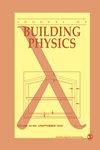Experimental method for estimating the effect of solar radiation on the inner surface heat flux of opaque building envelope elements
IF 1.4
4区 工程技术
Q3 CONSTRUCTION & BUILDING TECHNOLOGY
引用次数: 0
Abstract
There still exists a considerable difference when comparing the real and the design energy consumption of buildings. The difference between the design and the real building envelope energy performance is one of its main reasons. The building envelope can be characterised through the individual characterisation of its different building envelope components such as opaque walls or windows. Therefore, the estimation of parameters such as their transmission heat transfer coefficient (UA) and their solar aperture (gA) is usually implemented. Although building components have been analysed over the years, the thermal characteristics of buildings have mainly been estimated through steady-state laboratory tests and simplified calculation/simulation procedures based on theoretical data. The use of inverse modelling based on registered dynamic data has also been used; however, unfortunately, the models used tend to significantly simplify or neglect the solar radiation effect on the inner surface heat flux of opaque building envelope elements. Therefore, this work presents an experimental, dynamic and inverse modelling method that accurately models non-linear phenomena through the use of a user-friendly simulation programme (LORD). The method is able to analyse in detail the effect of the solar radiation on the inner surface heat flux of opaque building envelope elements, without the necessity of knowing their constructive details or thermal properties. The experiment is performed in a fully monitored test box, where different models are tested with different opaque walls to find the best fit. Finally, the solar irradiance signal is removed from the best models so as to accurately quantify the weight of the solar radiation on the inner surface heat flux of each wall for two extreme periods, one for sunny summer days and other for cloudy winter days.估算太阳辐射对不透明建筑围护结构内表面热通量影响的实验方法
在比较建筑物的实际能耗和设计能耗时,仍然存在相当大的差异。建筑围护结构的设计能耗与实际能耗之间的差异是其主要原因之一。建筑围护结构可以通过对不同的建筑围护结构部件(如不透明墙体或窗户)进行单独表征。因此,通常要对其透射传热系数(UA)和太阳孔径(gA)等参数进行估算。尽管多年来一直在对建筑部件进行分析,但建筑物的热特性主要是通过稳态实验室测试和基于理论数据的简化计算/模拟程序进行估算的。然而,遗憾的是,所使用的模型往往大大简化或忽略了太阳辐射对不透明建筑围护结构内表面热通量的影响。因此,这项工作提出了一种实验、动态和反向建模方法,通过使用用户友好的模拟程序(LORD)对非线性现象进行精确建模。该方法能够详细分析太阳辐射对不透明建筑围护结构内表面热通量的影响,而无需了解其构造细节或热特性。实验在一个完全受监控的测试箱中进行,用不同的不透明墙体对不同的模型进行测试,以找到最佳匹配。最后,从最佳模型中剔除太阳辐照信号,以便准确量化太阳辐射在两个极端时期对每面墙内表面热通量的影响,一个是夏季晴天,另一个是冬季阴天。
本文章由计算机程序翻译,如有差异,请以英文原文为准。
求助全文
约1分钟内获得全文
求助全文
来源期刊

Journal of Building Physics
工程技术-结构与建筑技术
CiteScore
5.10
自引率
15.00%
发文量
10
审稿时长
5.3 months
期刊介绍:
Journal of Building Physics (J. Bldg. Phys) is an international, peer-reviewed journal that publishes a high quality research and state of the art “integrated” papers to promote scientifically thorough advancement of all the areas of non-structural performance of a building and particularly in heat, air, moisture transfer.
 求助内容:
求助内容: 应助结果提醒方式:
应助结果提醒方式:


